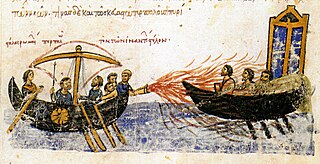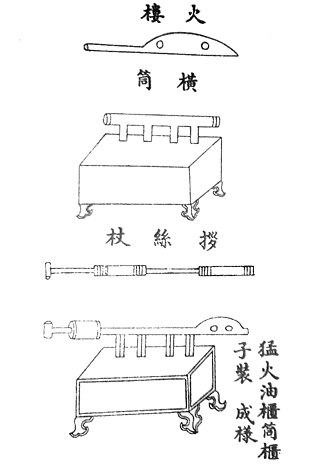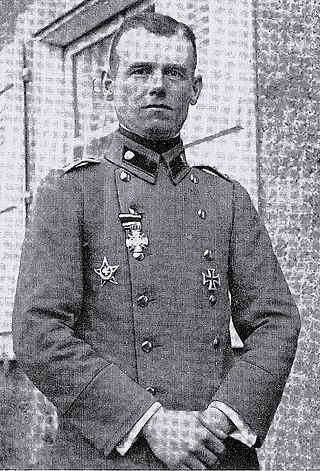Related Research Articles

Greek fire was an incendiary weapon used by the Eastern Roman Empire beginning AD 672. Used to set enemy ships on fire, it consisted of a combustible compound emitted by a flame-throwing weapon. Some historians believe it could be ignited on contact with water, and was probably based on naphtha and quicklime. The Byzantines typically used it in naval battles to great effect, as it could continue burning while floating on water. The technological advantage it provided was responsible for many key Byzantine military victories, most notably the salvation of Constantinople from the first and second Arab sieges, thus securing the empire's survival.

A Molotov cocktail is a hand-thrown incendiary weapon constructed from a frangible container filled with flammable substances equipped with a fuse. In use, the fuse attached to the container is lit and the weapon is thrown, shattering on impact. This ignites the flammable substances contained in the bottle and spreads flames as the fuel burns.

A flamethrower is a ranged incendiary device designed to project a controllable jet of fire. First deployed by the Byzantine Empire in the 7th century AD, flamethrowers saw use in modern times during World War I, and more widely in World War II as a tactical weapon against fortifications.

Robert Hutchings Goddard was an American engineer, professor, physicist, and inventor who is credited with creating and building the world's first liquid-fueled rocket. Goddard successfully launched his rocket on March 16, 1926, which ushered in an era of space flight and innovation. He and his team launched 34 rockets between 1926 and 1941, achieving altitudes as high as 2.6 km (1.6 mi) and speeds as fast as 885 km/h (550 mph).

Early thermal weapons, which used heat or burning action to destroy or damage enemy personnel, fortifications or territories, were employed in warfare during the classical and medieval periods.

The Type 93 and Type 100 flamethrowers were flamethrowers used by the Imperial Japanese Army and Imperial Japanese Navy's SNLF during the Second Sino-Japanese War and World War II.

The Flamethrower, Portable, No 2, also known as the Ack Pack, was a British design of flamethrower for infantry use in the Second World War.

The Flammenwerfer 35, or FmW 35 was a one-man German flamethrower used during World War II to clear out trenches and buildings. It could project fuel up to 25 meters from the user.

Meng Huo You is the name given to petroleum in ancient China, which practiced the use of petroleum as an incendiary weapon in warfare.

The Einstossflammenwerfer 46 was a hand held single shot flamethrower designed in Germany during the second half of World War II and introduced in 1944; it was engineered to be both cheap and easily mass-produced. The disposable weapon fired a half-second burst of flame of up to 27 metres (89 ft). It was issued to the Volkssturm or the Werwolf movement, but also used by the Fallschirmjäger . It was inspired by the Italian "Lanciafiamme Mod. 41 d'assalto"

The Wechselapparat (Wex) was a World War I German flamethrower introduced in 1916 to replace the earlier Kleif. Developed by Richard Fiedler, as early as 1901. It had a doughnut-shaped backpack fuel container with a spherical propellant container (nitrogen) in the middle that blasted the gasoline. The containers were made of welded car rims, which made it easier to carry it yourself. A corrugated rubber hose led from the tank at the ends of which there were valves that enables mixture of fuel and propellant dispensing under pressure to the metal fuel pipe which had handles on both sides. Wex used a magnesium ignition system in a nozzle. In order for the fire to burn longer, tar was added to the gasoline or instead of it fuel oil was completely used up. It was used throughout the war, and some survived flamethrowers have been used by the Finns in the 1920s and then converted to Flammenwerfer 40. This design was updated before the Second World War to become flamethrower model 35. However, model 35 was considered too fragile so it was soon replaced by the model 41, a simpler construction with smaller, horizontal, cylindrical backpack containers.

A fire extinguisher is a handheld active fire protection device usually filled with a dry or wet chemical used to extinguish or control small fires, often in emergencies. It is not intended for use on an out-of-control fire, such as one which has reached the ceiling, endangers the user, or otherwise requires the equipment, personnel, resources, and/or expertise of a fire brigade. Typically, a fire extinguisher consists of a hand-held cylindrical pressure vessel containing an agent that can be discharged to extinguish a fire. Fire extinguishers manufactured with non-cylindrical pressure vessels also exist but are less common.

The Flammenwerfer M.16. literally meaning it "throws flames" in German was a German man-portable backpack flamethrower that was used in World War I in trench warfare by the Germans. It was the first flamethrower ever used in combat, in 1916 at Verdun by the Germans. It was also used in 1918 in the battle of Argonne Forest in France against Allied forces by Germans, as featured in the 2001 film The Lost Battalion where the main character fights German, although an account in a 1917 issue of The Living Age suggests eye witness accounts of it being used at the Battle of the Somme in 1916 by Germans.

The M1 and M1A1 were portable flamethrowers developed by the United States during World War II. The M1 weighed 72 lb, had a range of 15 meters, and had a fuel tank capacity of five gallons. The improved M1A1 weighed less, at 65 lb, had a much longer range of 45 meters, had the same fuel tank capacity, and fired thickened fuel (napalm).
The Petroleum Warfare Department (PWD) was a government department established in Britain in 1940 in response to the invasion crisis during World War II, when Germany apparently would invade the country. The department was initially tasked with developing the uses of petroleum as a weapon of war, and it oversaw the introduction of a wide range of flame warfare weapons. Later in the war, the department was instrumental in the creation of the Fog Investigation and Dispersal Operation that cleared runways of fog allowing the landing of aircraft returning from bombing raids over Germany in poor visibility, and Operation Pluto, which installed prefabricated fuel pipelines between England and France soon after the Allied invasion of Normandy in June 1944.
Livens Large Gallery Flame Projectors were large experimental flamethrowers used by the British Army in World War I, named after their inventor, Royal Engineers officer William Howard Livens.

The Flammenwerfer 41, or FmW 41 was the standard German flamethrower beginning in 1941 and an upgraded version of the earlier Flammenwerfer 35, whose main issue was its excessive weight of 36kg, with the Flammenwerfer 41 being only 18. It performed a similar role of other flamethrowers of the time, namely clearing enemy trenches and buildings in highly fortified areas. From 1942 to April 1945, 64,284 examples were produced. After 1945, flamethrowers gradually saw less usage, and the Bundeswehr does not use any.

Willy Martin Ernst Rohr was a German Army officer who was a major contributor to the development of infantry tactics in World War I, particularly for the system of Storm Battalions.

The Lanciafiamme Spalleggiato Modello 35, also known as Model 35, was a flamethrower issued to the Royal Italian Army in the Second Italo-Ethiopian War. In 1940 it was replaced by the Lanciafiamme Spalleggiato Modello 40, which uses a different ignition system.

In the United States, flamethrowers are broadly legal for personal ownership and use. California requires a permit for the possession of a flamethrower, and only Maryland has outright banned their ownership and use. No federal laws exist regarding flamethrowers, as they are not defined as weapons under the National Firearms Act. The United States is a signatory of the Convention on Certain Conventional Weapons, protocol III of which limits military use of flamethrowers; this does not extend to civilian use.
References
- ↑ Markus Lippold: Stahlhelm, Giftgas und 08/15, Weltkrieg macht erfinderisch. n-tv, 23. Juni 2014.
- ↑ Thomas Wictor Flammenwerfer ! The death head pioneers
- ↑ Wolfgang Fleischer: Militärtechnik des Ersten Weltkriegs. Entwicklung, Einsatz, Konsequenzen. Motorbuch Verlag, Stuttgart 2014, ISBN 978-3-613-03706-9, S. 178.
- ↑ Erfolgreiche Spurensucher - REDDEMANN-Ausstellung im Feuerwehrmuseum, Osthessen-News, 11. August 2010, Fulda
- ↑ Die kleine Bildgeschichte, Welt am Sonntag, 19. Juni 2011
- ↑ Automobiltechnische Zeitschrift Bd. 20, 1917, S. 25; "Fiedler+flammenapparate" Vorschau